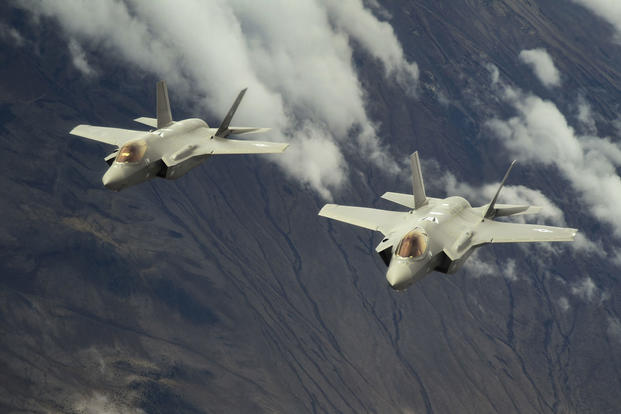The F-35As at Luke Air Force Base, Arizona, will be back in the air Wednesday after officials paused operations following a string of hypoxia-related incidents.
The Air Force on Tuesday said operations for the 55 Joint Strike Fighters at the base will resume, though officials have yet to find a root cause behind pilots experiencing oxygen deprivation symptoms in flight.
"No specific root cause for the physiological events was identified during recent visits from experts and engineers from the Joint Program Office, Lockheed Martin, the Air Force Research Laboratory and other organizations," said Maj. Rebecca Heyse, a Luke spokeswoman.
"However, specific concerns were eliminated as possible causes, including maintenance and aircrew flight equipment procedures," she said in a statement.
Related content:
- Air Force: No Clear Cause for F-35A Hypoxia-Related Problem
- F-35A Hypoxia Problems Date Back to 2011, Air Force Reveals
- Could This Next-Gen Cockpit System End Hypoxia-Like Incidents?
Last week, Brig. Gen. Brook Leonard, the 56th Fighter Wing commander, echoed similar conclusions.
Without giving specifics, Leonard said, "We did eliminate a lot of areas" of possible causes on the maintenance and aircrew management side of operations.
"The solution is going to be a very multi-layered human and machine solution," he said during a phone call with reporters Friday. "We're progressing toward that."
The Air Force is taking precautions and making pilot safety a priority, he added.
Heyse said the following criteria are temporarily in place for pilots at Luke: avoid the altitudes in which all five physiological events occurred; modify ground procedures to mitigate physiological risks to pilots; expand physiological training to increase understanding between pilots and medical communities; increase minimum levels for backup oxygen systems for each flight; and offer pilots the option of wearing sensors during flight to collect human performance data.
"Our active-duty, reserve and international team has worked tirelessly to better understand the physiological events," Leonard said Tuesday. "This is a complex challenge that necessitates multidimensional solutions across a series of steps to get back to a full operating capability. We are confident that this initial step with the criteria our team developed will allow us to return to flying F-35s safely and to continue building the future of airpower."
Since May 2, five F-35A pilots have experienced "physiological incidents while flying," the service has said. In each case, the aircraft's backup oxygen system kicked in and the pilot followed the correct procedures to land safely.
Air Force officials disclosed to Military.com recently that there have been 15 reported F-35A in-flight and ground physiological events since April 2, 2011, including the most recent events at Luke.
Leonard on Friday added that within that same timeframe, 23 cases have occurred across the Joint Strike Fighter fleet -- 15 Air Force models, three Marine Corps B models, and five Navy C models. He said the other services' incidents occurred "some years back."
In the 23 cases, 13 -- across all three models -- were discovered to have a root cause, the commander said.
A defense official told Military.com on Friday those 13 were plagued by "pressure issues, contaminated oxygen and ground events."
Ground events, for example, could be attributed to "lots of jets on a ramp, of which exhaust fumes may have played a role," the official said.
The remaining 10 remain unexplained. "We may never arrive at a determination for some of these," the official said.
As for recent events, which are limited to Luke, "Some are specific to the person," the defense official said. "How they were flying, at what altitude they were flying," and other variables could play a role, the official said.
It remains unclear if pilots at other F-35 bases such as Hill Air Force Base, Utah, or Eglin Air Force Base, Florida, have reported similar incidents.
-- Oriana Pawlyk can be reached at oriana.pawlyk@military.com. Follow her on Twitter at@Oriana0214.




























